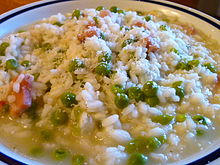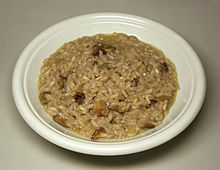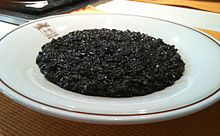Risotto
![]()
The title of this article is ambiguous. For steamed rice, see pilaf.
The or risotto ([riˈzɔtto] (![]() ) or southern Italian [riˈsɔtto]) (
) or southern Italian [riˈsɔtto]) (![]() ) is a northern Italian porridge dish made from rice, prepared in a number of variations. Characteristic of almost all preparation methods is that medium-grain rice and onions are sautéed in fat and cooked in broth until the dish is creamy, but the rice grains are still firm to the bite. Depending on the recipe, wine, mushrooms, seafood, meat, vegetables, rarely fruit (strawberries, apples, blueberries), spices and cheese (usually Parmesan) are added.
) is a northern Italian porridge dish made from rice, prepared in a number of variations. Characteristic of almost all preparation methods is that medium-grain rice and onions are sautéed in fat and cooked in broth until the dish is creamy, but the rice grains are still firm to the bite. Depending on the recipe, wine, mushrooms, seafood, meat, vegetables, rarely fruit (strawberries, apples, blueberries), spices and cheese (usually Parmesan) are added.
Rice has been known in Italy since the Renaissance and is mainly grown in the Po Valley. The best known varieties suitable for risotto are Arborio, Vialone and Carnaroli. Broken rice, which is often sold as rice pudding, is not suitable because it does not obtain the desired consistency during preparation. Long-grain rice, regardless of quality, is also unsuitable for risotto, as it releases too little of the starch responsible for the creamy consistency when cooked al dente.
In Italian cuisine, risotto is served as the first main course (primo piatto) or as a side dish to a stew, such as risotto alla milanese to ossobuco.

Risotto with fennel and lemon

Grilled shrimps on risotto with lemon and chives
Typical risotto dishes
Basic recipe
To prepare, chopped onions are sauteed in fat until translucent, dry rice is added and sweated a little. Then deglaze with hot meat or poultry stock, often also with wine at the beginning. During the cooking time, boiling hot liquid must be added again and again and stirred. Depending on the recipe, the finished risotto should still be more or less soupy, the rice creamy on the outside and firm to the bite on the inside. Finally, add a little butter and, in most recipes, grated Parmesan.
Risotto bianco
Risotto bianco (white risotto as a side dish) is prepared according to the basic recipe. Add some fresh sage to the onions and deglaze with a glass of white wine. The risotto is finished with butter and Parmesan cheese.
Risotto alla milanese
Risotto alla milanese (Milanese saffron rice) is coloured with saffron threads, beef bone marrow is used to sauté the onions with a little butter, which together with the saffron gives the dish its typical aroma. Other ingredients are butter and Parmesan cheese at the end. Opinions are divided on whether wine should be used. If so, the traditional method is to deglaze the sauteed rice with a glass of red wine (or white wine in modern recipes) before adding the broth. The best broth is considered to be that which results from the preparation of bollito misto, a sumptuous simmering of chicken, beef and veal.
Risotto agli asparagi
Risotto agli asparagi (risotto with asparagus) is prepared with (mostly green) asparagus. The tips of the asparagus are cut off. The chopped stalks are cooked in salted water and the cooking juices are used for the risotto instead of stock. The asparagus heads are steamed separately in a little butter. They are added to the risotto at the end of the preparation together with the asparagus pieces after the butter and the Parmesan.
risotto nero
Risotto nero (black risotto) is prepared with small squid. It gets its colour from their ink sacs. The cleaned squid are cut into strips and sauteed with onions, garlic and parsley in olive oil, deglazed with white wine and cooked. Then the rice and the ink are added. Further preparation follows the basic recipe. Fish stock is used as the liquid. Instead of butter and cheese, only plenty of black pepper is added at the end. As a side dish, risotto nero can also be prepared with ink only - without squid. In some fish shops, ink is available pre-packed.
Risotto ai funghi
Risotto ai funghi (risotto with mushrooms) is prepared like risotto bianco. Instead of sage, sliced porcini mushrooms or other edible mushrooms are sautéed with the onions and deglazed with white wine. Soaked dried mushrooms can also be used.
Risi e bisi
Risi e bisi (rice with peas; also called risibisi or risi-pisi) is a classic of Venetian cuisine, served annually as the first course to the Doge of Venice on St Mark's Day. To prepare it, bacon, onions and parsley are sautéed in a mixture of olive oil and butter, the young peas and a little strong meat stock (possibly with meat extract) are added and everything is stewed for a short time. Then fill up with boiling meat broth, add the rice and cook. After seasoning with salt, pepper and sugar, butter and parmesan are mixed in. Very young peas can be used with the pods.

Risi e bisi

Risotto with dried porcini mushrooms
.jpg)
Risotto alla milanese with pistachios

risotto nero
Questions and Answers
Q: What is risotto?
A: Risotto is a typical Italian dish based on rice, cooked in broth to a creamy consistency.
Q: Where does risotto originate from and where is it commonly grown?
A: Risotto originates from Piedmont, Italy, where rice is commonly grown.
Q: What are the common ingredients in the base recipe of risotto?
A: The common ingredients in the base recipe of risotto are white wine and onions.
Q: What kind of broth is used to make risotto?
A: The broth used to make risotto can be meat-, fish-, or vegetable-based.
Q: What are some common additions to risotto?
A: Parmesan cheese, butter, and onion are common additions to risotto.
Q: How is risotto typically served in Italy?
A: Risotto is typically served as a primo (first course), served on its own before the main course.
Q: What is risotto alla milanese often served with?
A: Risotto alla milanese is often served together with ossobuco alla milanese.
Search within the encyclopedia